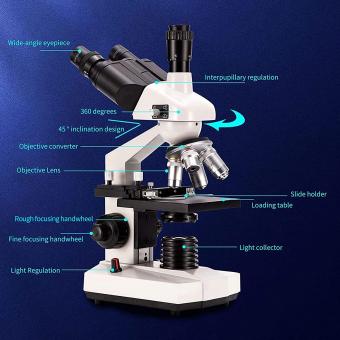Can You See Mitochondria With A Light Microscope ?
Yes, mitochondria can be seen with a light microscope. However, due to their small size and transparent nature, they may not be easily visible without staining or using specialized techniques such as fluorescence microscopy.
1、 Mitochondrial structure and morphology
Yes, mitochondria can be seen with a light microscope. However, due to their small size and transparent nature, they are not easily visible without staining or specific techniques. Mitochondria are typically stained using dyes that specifically target their membranes or DNA, allowing them to be visualized under a light microscope.
Mitochondrial structure and morphology have been extensively studied using electron microscopy, which provides higher resolution and more detailed images. Electron microscopy has revealed that mitochondria have a double membrane structure, with an outer membrane and an inner membrane that folds inward to form structures called cristae. The inner membrane encloses the mitochondrial matrix, which contains the mitochondrial DNA, enzymes, and other components necessary for energy production.
Recent advancements in microscopy techniques, such as super-resolution microscopy, have allowed for even higher resolution imaging of mitochondria. These techniques have provided insights into the dynamic nature of mitochondria, revealing their ability to undergo fusion and fission events, as well as their interactions with other cellular structures.
It is important to note that while light microscopy can provide valuable information about mitochondrial structure and morphology, it has limitations in terms of resolution and the ability to observe dynamic processes. Therefore, a combination of light microscopy and electron microscopy techniques is often used to obtain a comprehensive understanding of mitochondrial biology.
In conclusion, while mitochondria can be seen with a light microscope, their visualization often requires staining or specific techniques. Electron microscopy and advanced microscopy techniques have provided more detailed insights into mitochondrial structure and dynamics.

2、 Mitochondrial function and energy production
Yes, you can see mitochondria with a light microscope. Mitochondria are small, membrane-bound organelles found in the cytoplasm of eukaryotic cells. They are responsible for various functions, including energy production through oxidative phosphorylation, regulation of cell death, and calcium homeostasis.
With a light microscope, mitochondria can be visualized using various staining techniques. One commonly used stain is MitoTracker, which selectively accumulates in active mitochondria and emits a fluorescent signal when excited by light. This allows researchers to observe and study the morphology, distribution, and dynamics of mitochondria in living cells.
However, it is important to note that the resolution of a light microscope is limited, typically around 200-300 nanometers. This means that the fine details of mitochondria, such as their inner membrane structures and cristae, may not be clearly visible. To study these structures in more detail, electron microscopy techniques, such as transmission electron microscopy (TEM), are often employed.
In recent years, advancements in microscopy techniques have allowed for improved visualization of mitochondria. Super-resolution microscopy techniques, such as stimulated emission depletion (STED) microscopy and structured illumination microscopy (SIM), have pushed the resolution limits beyond the diffraction barrier, enabling researchers to observe finer details of mitochondria and their substructures.
Furthermore, the development of genetically encoded fluorescent proteins, such as green fluorescent protein (GFP), has revolutionized the field of cell biology. By fusing GFP to specific mitochondrial proteins, researchers can selectively label and track mitochondria in living cells, providing valuable insights into their dynamics and function.
In conclusion, while a light microscope can be used to visualize mitochondria, its resolution is limited. However, with the advent of advanced microscopy techniques and fluorescent protein labeling, researchers can now study mitochondria in greater detail, shedding light on their crucial role in cellular function and energy production.

3、 Mitochondrial DNA and genetic inheritance
Can you see mitochondria with a light microscope? Yes, mitochondria can be observed using a light microscope. However, due to their small size and transparent nature, they are not easily visible without staining or using specialized techniques.
Mitochondria are double-membraned organelles found in most eukaryotic cells. They are responsible for producing energy in the form of ATP through cellular respiration. While they are too small to be seen directly with a light microscope, they can be visualized by staining techniques that highlight their structure and location within the cell.
One commonly used staining method is MitoTracker, a fluorescent dye that specifically targets mitochondria. This dye can be added to live cells, allowing researchers to observe the movement and distribution of mitochondria in real-time. Additionally, electron microscopy can provide high-resolution images of mitochondria, revealing their intricate internal structure.
It is important to note that while mitochondria can be observed with a light microscope, their DNA cannot be visualized using this technique. Mitochondrial DNA (mtDNA) is a small, circular genome that is separate from the nuclear DNA. It contains genes essential for mitochondrial function and is inherited exclusively from the mother. To study mtDNA, techniques such as polymerase chain reaction (PCR) and DNA sequencing are used.
In recent years, advancements in microscopy techniques, such as super-resolution microscopy, have allowed for even more detailed visualization of mitochondria. These techniques provide higher resolution and can reveal finer details of mitochondrial structure and dynamics.
In conclusion, while mitochondria themselves can be observed with a light microscope using staining techniques, their DNA cannot be visualized using this method. To study mitochondrial DNA and genetic inheritance, more specialized techniques are required.

4、 Mitochondrial dynamics and fusion-fission processes
Yes, mitochondria can be observed with a light microscope. However, due to their small size and transparent nature, they are not easily visible without specific staining techniques or fluorescent labeling. Mitochondria are typically stained using dyes that specifically target their membranes or mitochondrial DNA, allowing them to be visualized under a light microscope.
Mitochondrial dynamics and fusion-fission processes refer to the continuous changes in the shape, size, and distribution of mitochondria within cells. These processes are crucial for maintaining mitochondrial function and cellular homeostasis. In recent years, there have been significant advancements in our understanding of mitochondrial dynamics, largely due to the development of advanced imaging techniques.
One such technique is live-cell imaging using fluorescent proteins targeted to mitochondria. This allows researchers to track the movement and fusion-fission events of mitochondria in real-time. Additionally, super-resolution microscopy techniques, such as stimulated emission depletion (STED) microscopy and structured illumination microscopy (SIM), have provided higher resolution images of mitochondria, enabling the visualization of their intricate structures and dynamics.
Furthermore, advancements in electron microscopy have allowed for the visualization of mitochondria at an even higher resolution. Electron microscopy techniques, such as transmission electron microscopy (TEM) and focused ion beam scanning electron microscopy (FIB-SEM), have revealed detailed ultrastructural information about mitochondrial morphology and dynamics.
In conclusion, while mitochondria can be observed with a light microscope, the use of advanced imaging techniques has greatly enhanced our understanding of mitochondrial dynamics and fusion-fission processes. These techniques have provided valuable insights into the complex and dynamic nature of mitochondria within cells.









































